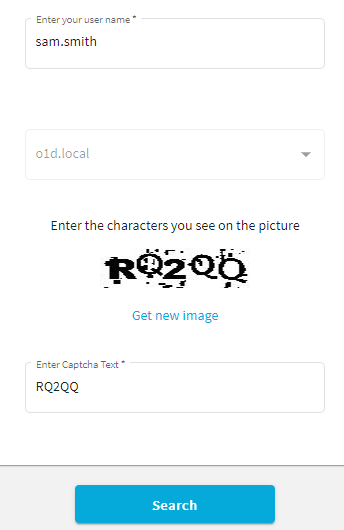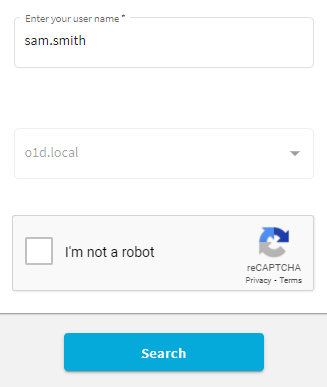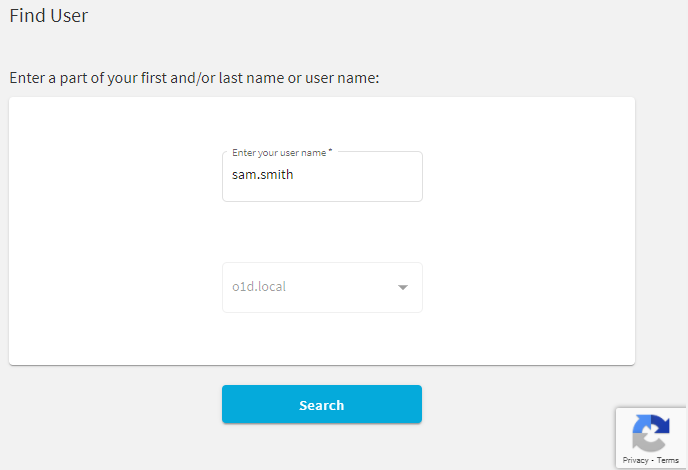To prevent bot attacks against your One Identity Password Manager deployment, you can configure anti-bot security measures for the Find User page of the Self-Service Site. Password Manager supports configuring CAPTCHA images and reCAPTCHA v2 or v3 security solutions.
You can configure the One Identity Password Manager Self-Service Site to display CAPTCHA images on its Find User page as an anti-bot security measure.

To configure CAPTCHA images for the Self-Service Site
-
In the Password Manager Administration Site, navigate to General Settings > Search and Logon Options.
-
Scroll down to Security Settings.
-
To enable the CAPTCHA or reCAPTCHA settings, enable Show a security image to prevent bot attacks.
-
To configure the CAPTCHA settings, select Display CAPTCHA and click Settings.
-
In the CAPTCHA Settings dialog, configure the following options:
-
Number of characters: Specify the number of characters (1–15) to display on the generated CAPTCHA image. The default value is 5.
-
Noise level: Specify the number and size of noise artifacts on the generated CAPTCHA image. Higher levels mean more difficult readability.
When ready, click OK.
-
Under Security Settings, select Show a security image every time the search is performed to perform the configured anti-bot protection check each time a search is performed on the Find User page of the Self-Service Site.
TIP: Enable this setting for an increased protection against bot attacks.
-
To apply your settings, click Save.
You can configure the Find User page of the One Identity Password Manager Self-Service Site to include reCAPTCHA anti-bot protection. Password Manager supports the reCAPTCHA v2 and v3 engines.
NOTE: Password Manager supports only the "I'm not a robot" Checkbox challenge of reCAPTCHA v2. It does not support the Invisible reCAPTCHA badge and reCAPTCHA Android app validations.
Prerequisites
Before you configure reCAPTCHA v2 or v3 protection for the Password Manager Self-Service Site, make sure that the following conditions are met:
-
The server running Password Manager has an active Internet connection and can communicate with the Google reCAPTCHA endpoint.
-
You must sign up and generate a reCAPTCHA site key and secret key from Google. For more information, see the Google reCAPTCHA portal.
NOTE: When generating the keys on the Google reCAPTCHA Admin site, provide the domain name(s) where the Password Manager Self-Service Site(s) are deployed. If multiple Self-Service Sites are deployed in several different domains, provide all the domains to generate the required number of site keys and secret keys.
To configure reCAPTCHA protection for the Self-Service Site
-
In the Password Manager Administration Site, navigate to General Settings > Search and Logon Options.
-
Scroll down to Security Settings.
-
To enable the CAPTCHA or reCAPTCHA settings, enable Show a security image to prevent bot attacks.
-
To configure the reCAPTCHA settings, select Display reCAPTCHA and click Settings.
-
In the reCAPTCHA Settings dialog, configure the following options:
-
Version: Select the reCAPTCHA version to use (v2 or v3).
-
Site key: Enter the site key generated on the Google reCAPTCHA Admin site.
-
Secret key: Enter the secret key generated on the Google reCAPTCHA Admin site.
-
Theme: Select the visual theme (Light or Dark) to use with the reCAPTCHA widget.
NOTE: This setting is available only for reCAPTCHA v2.
-
Enter reCAPTCHA v3 Score: Specify the reCAPTCHA v3 score threshold (0.0–1.0) under which the interaction is considered to be a bot attempt. The default value is 0.5, and One Identity recommends using it until further adjustments are made based on actual site traffic.
NOTE: This setting is available only for reCAPTCHA v3.
When ready, click OK.
-
Under Security Settings, select Show a security image every time the search is performed to perform the configured anti-bot protection check each time a search is performed on the Find User page of the Self-Service Site.
TIP: Enable this setting for an increased protection against bot attacks.
-
To apply your settings, click Save.
Once you configured reCAPTCHA, the Find User page of the Self-Service Site will be updated to include the configured anti-bot protection method:
-
If reCAPTCHA v2 is configured, the I'm not a robot check box widget appears.

-
If reCAPTCHA v3 is configured, the reCAPTCHA widget appears at the bottom right corner of the screen.

You can export and import the configuration settings of Password Manager instance. You can export the configuration to a configuration file to back up the instance or create replicas of the existing instance. You can import the configuration to join the current Password Manager instance to an existing realm.



